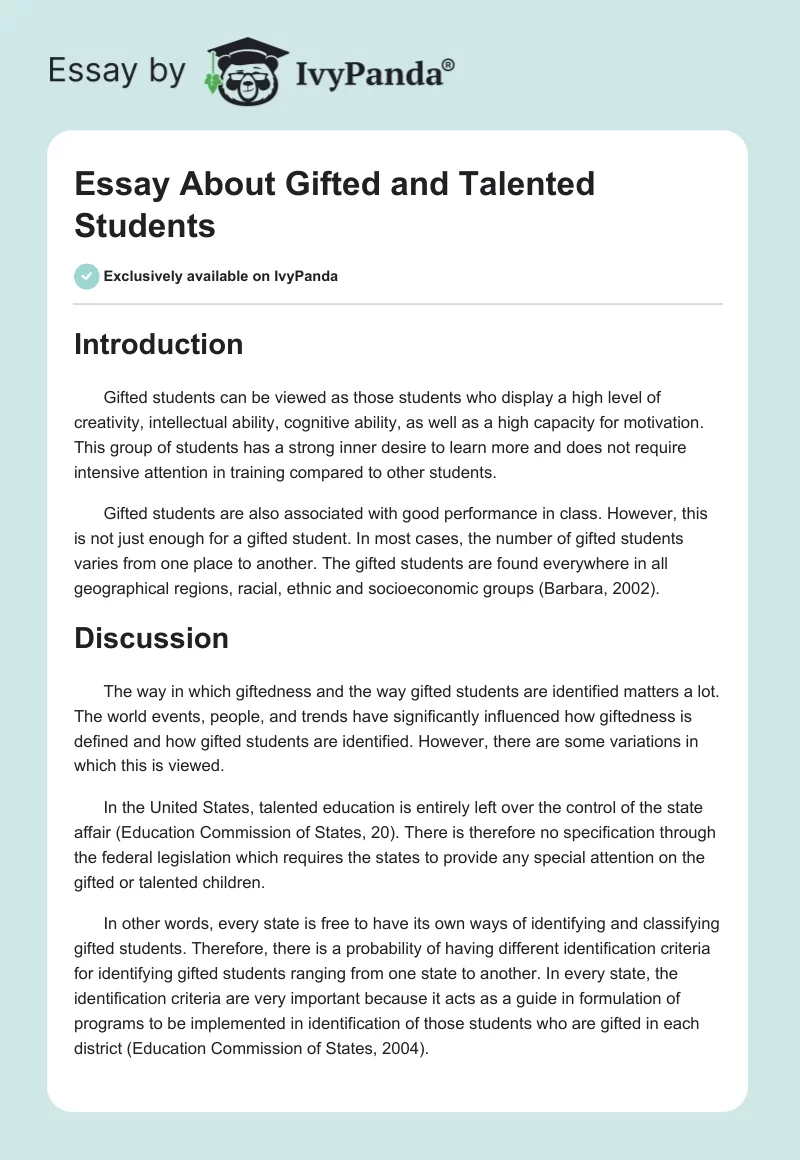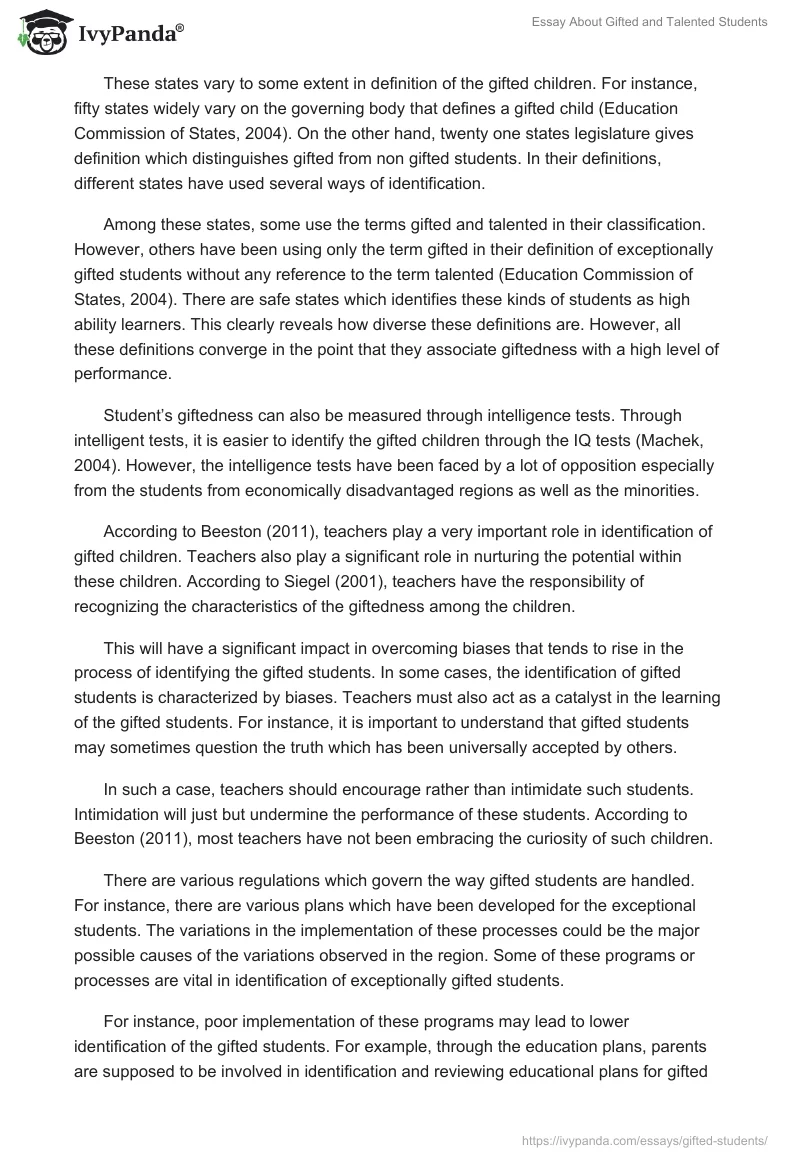Introduction
Gifted students can be viewed as those students who display a high level of creativity, intellectual ability, cognitive ability, as well as a high capacity for motivation. This group of students has a strong inner desire to learn more and does not require intensive attention in training compared to other students.
Gifted students are also associated with good performance in class. However, this is not just enough for a gifted student. In most cases, the number of gifted students varies from one place to another. The gifted students are found everywhere in all geographical regions, racial, ethnic and socioeconomic groups (Barbara, 2002).
Discussion
The way in which giftedness and the way gifted students are identified matters a lot. The world events, people, and trends have significantly influenced how giftedness is defined and how gifted students are identified. However, there are some variations in which this is viewed.
In the United States, talented education is entirely left over the control of the state affair (Education Commission of States, 20). There is therefore no specification through the federal legislation which requires the states to provide any special attention on the gifted or talented children.
In other words, every state is free to have its own ways of identifying and classifying gifted students. Therefore, there is a probability of having different identification criteria for identifying gifted students ranging from one state to another. In every state, the identification criteria are very important because it acts as a guide in formulation of programs to be implemented in identification of those students who are gifted in each district (Education Commission of States, 2004).
These states vary to some extent in definition of the gifted children. For instance, fifty states widely vary on the governing body that defines a gifted child (Education Commission of States, 2004). On the other hand, twenty one states legislature gives definition which distinguishes gifted from non gifted students. In their definitions, different states have used several ways of identification.
Among these states, some use the terms gifted and talented in their classification. However, others have been using only the term gifted in their definition of exceptionally gifted students without any reference to the term talented (Education Commission of States, 2004). There are safe states which identifies these kinds of students as high ability learners. This clearly reveals how diverse these definitions are. However, all these definitions converge in the point that they associate giftedness with a high level of performance.
Student’s giftedness can also be measured through intelligence tests. Through intelligent tests, it is easier to identify the gifted children through the IQ tests (Machek, 2004). However, the intelligence tests have been faced by a lot of opposition especially from the students from economically disadvantaged regions as well as the minorities.
According to Beeston (2011), teachers play a very important role in identification of gifted children. Teachers also play a significant role in nurturing the potential within these children. According to Siegel (2001), teachers have the responsibility of recognizing the characteristics of the giftedness among the children.
This will have a significant impact in overcoming biases that tends to rise in the process of identifying the gifted students. In some cases, the identification of gifted students is characterized by biases. Teachers must also act as a catalyst in the learning of the gifted students. For instance, it is important to understand that gifted students may sometimes question the truth which has been universally accepted by others.
In such a case, teachers should encourage rather than intimidate such students. Intimidation will just but undermine the performance of these students. According to Beeston (2011), most teachers have not been embracing the curiosity of such children.
There are various regulations which govern the way gifted students are handled. For instance, there are various plans which have been developed for the exceptional students. The variations in the implementation of these processes could be the major possible causes of the variations observed in the region. Some of these programs or processes are vital in identification of exceptionally gifted students.
For instance, poor implementation of these programs may lead to lower identification of the gifted students. For example, through the education plans, parents are supposed to be involved in identification and reviewing educational plans for gifted students (Department of Education, 2006). However, this identification may differ from one individual to another. For instance, a parent may have two children who are both exceptional.
However, their levels may differ. This parent may be tempted to believe that the other is not gifted through comparison. However, the two may all be gifted. In other words, the difference may be brought through identification criteria.
Conclusion
In conclusion, this discussion has clearly shown that the world events, people, and trends have significantly influenced how giftedness is defined and how gifted students are identified. It has been identified that different states has their unique ways of definition of gifted and non gifted students.
Some emphasizes on the term giftedness while others on the term talented. However, there are still a few states that use the term high ability to define giftedness. This identification plays a significant role in implementation of the educational programs at the district level.
Reference List
Barbara, C. (2002). Growing up Gifted. U.S.A: Merrill Prentice Hall. Beeston, D. (2011). The Early Years of Albert Einstein: When viewed through the lens of current theory and research were there signs of giftedness? The New Zealand Journal of Gifted Education. Vol. 16, No. 1.
Department of Education. (2006). Development of Educational Plans for Exceptional Students Who Are Gifted. Web.
Education Commission of States. (2004). State Gifted and Talented Definitions. Web.
Machek, G. (2004). The Role of Standardized Intelligence Measures in Testing for Giftedness. Web.
Siegel, D. (2001). Overcoming bias in Gifted and talented Referrals. Web.


